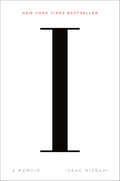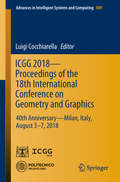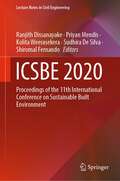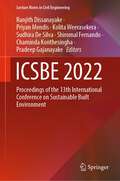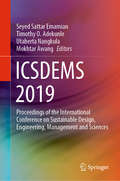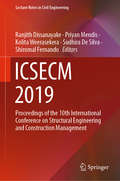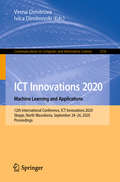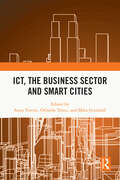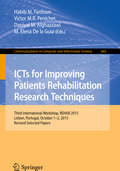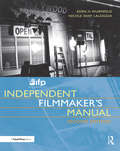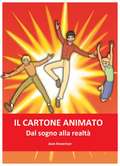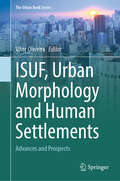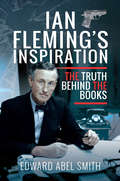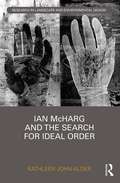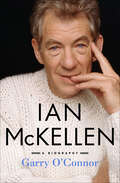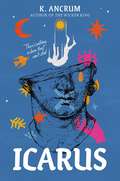- Table View
- List View
I. M.: A Memoir
by Isaac MizrahiIn I.M., Isaac Mizrahi offers a poignant, candid, and touching look back on his life so far. Growing up gay in a sheltered Syrian Jewish Orthodox family, Isaac had unique talents that ultimately drew him into fashion and later into celebrity circles that read like a who’s who of the twentieth and twenty-first centuries: Richard Avedon, Audrey Hepburn, Anna Wintour, Mikhail Baryshnikov, Meryl Streep, and Oprah Winfrey, to name only a few. <P><P> In his elegant memoir, Isaac delves into his lifelong battles with weight, insomnia, and depression. He tells what it was like to be an out gay man in a homophobic age and to witness the ravaging effects of the AIDS epidemic. Brimming with intimate details and inimitable wit, Isaac's narrative reveals not just the glamour of his years, but the grit beneath the glitz. Rich with memorable stories from in and out of the spotlight, I.M. illuminates deep emotional truths.
I: A Memoir
by Isaac MizrahiINSTANT NEW YORK TIMES BESTSELLER“In I.M., Isaac Mizrahi puts his life to paper with the same mix of spirit and wryness as the designs he popularized.” —Vanity FairIsaac Mizrahi is sui generis: designer, cabaret performer, talk-show host, a TV celebrity. Yet ever since he shot to fame in the late 1980s, the private Isaac Mizrahi has remained under wraps. Until now.In I.M., Isaac Mizrahi offers a poignant, candid, and touching look back on his life so far. Growing up gay in a sheltered Syrian Jewish Orthodox family, Isaac had unique talents that ultimately drew him into fashion and later into celebrity circles that read like a who’s who of the twentieth and twenty-first centuries: Richard Avedon, Audrey Hepburn, Anna Wintour, Mikhail Baryshnikov, Meryl Streep, and Oprah Winfrey, to name only a few. In his elegant memoir, Isaac delves into his lifelong battles with weight, insomnia, and depression. He tells what it was like to be an out gay man in a homophobic age and to witness the ravaging effects of the AIDS epidemic. Brimming with intimate details and inimitable wit, Isaac's narrative reveals not just the glamour of his years, but the grit beneath the glitz. Rich with memorable stories from in and out of the spotlight, I.M. illuminates deep emotional truths.
ICGG 2018 - Proceedings of the 18th International Conference on Geometry and Graphics: 40th Anniversary - Milan, Italy, August 3-7, 2018 (Advances in Intelligent Systems and Computing #809)
by Luigi CocchiarellaThis book gathers peer-reviewed papers presented at the 18th International Conference on Geometry and Graphics (ICGG), held in Milan, Italy, on August 3-7, 2018. The spectrum of papers ranges from theoretical research to applications, including education, in several fields of science, technology and the arts. The ICGG 2018 mainly focused on the following topics and subtopics: Theoretical Graphics and Geometry (Geometry of Curves and Surfaces, Kinematic and Descriptive Geometry, Computer Aided Geometric Design), Applied Geometry and Graphics (Modeling of Objects, Phenomena and Processes, Applications of Geometry in Engineering, Art and Architecture, Computer Animation and Games, Graphic Simulation in Urban and Territorial Studies), Engineering Computer Graphics (Computer Aided Design and Drafting, Computational Geometry, Geometric and Solid Modeling, Image Synthesis, Pattern Recognition, Digital Image Processing) and Graphics Education (Education Technology Research, Multimedia Educational Software Development, E-learning, Virtual Reality, Educational Systems, Educational Software Development Tools, MOOCs). Given its breadth of coverage, the book introduces engineers, architects and designers interested in computer applications, graphics and geometry to the latest advances in the field, with a particular focus on science, the arts and mathematics education.
ICSBE 2018: Proceedings of the 9th International Conference on Sustainable Built Environment (Lecture Notes in Civil Engineering #44)
by Ranjith Dissanayake Priyan MendisThis book highlights current research and development in the area of sustainable built environments, currently one of the most important disciplines in civil engineering. It covers a range of topics, including sustainable construction and infrastructures, waste and wastewater management, enhanced sustainability, renewable and clean energy, sustainable materials and industrial ecology, building automation and virtual reality, and impact of climate change. As such it provides vital insights into responsible urbanization practices, and new tools and technologies in civil engineering that can mitigate the negative effects of the built environment.
ICSBE 2020: Proceedings of the 11th International Conference on Sustainable Built Environment (Lecture Notes in Civil Engineering #174)
by Ranjith Dissanayake Priyan Mendis Kolita Weerasekera Sudhira De Silva Shiromal FernandoThis book highlights the latest knowledge and innovations in the field of civil engineering and construction industry striving for a sustainable built environment. It includes recent innovative findings from the proceedings of the 11th ICSBE 2020 under the themes of sustainable tall buildings, sustainable bridge construction and maintenance, waste in construction industry, sustainable manufacturing and recycling, disaster risk reduction for sustainable built environment, green innovations and entrepreneurship, sustainable water management in developing countries, water pollution and CKDu, sustainable urban environment and social well-being, and many greener and sustainable resource and energy-efficient innovative research findings.
ICSBE 2022: Proceedings of the 13th International Conference on Sustainable Built Environment (Lecture Notes in Civil Engineering #362)
by Ranjith Dissanayake Priyan Mendis Kolita Weerasekera Sudhira De Silva Shiromal Fernando Chaminda Konthesingha Pradeep GajanayakeThis book highlights the latest knowledge and innovations in the fields of civil engineering and construction industry striving for a sustainable built environment. It consists of high quality and innovative research findings selected from the proceedings of the 13th ICSBE 2022 under the themes of sustainable construction, urban green infrastructure and planning, rainwater harvesting and water conservation, high-performance concrete, indoor environmental quality and indoor plants, wind and hydro-power energy, waste and wastewater management for enhanced sustainability, impacts of climate change, carbon footprint, global climate model and landscaping, material flows and industrial ecology, sustainable materials, etc.
ICSCEA 2021: Proceedings of the Second International Conference on Sustainable Civil Engineering and Architecture (Lecture Notes in Civil Engineering #268)
by J. N. Reddy Chien Ming Wang Van Hai Luong Anh Tuan LeThis book presents articles from the Second International Conference on Sustainable Civil Engineering and Architecture, held on 30 October 2021 in Ho Chi Minh City, Vietnam. The conference brings together international experts from both academia and industry to share their knowledge, expertise, to facilitate collaboration and improve cooperation in the field. The book highlights the latest advances in sustainable architecture and civil engineering, covering topics such as offshore structures, structural engineering, construction materials, and architecture.
ICSDEMS 2019: Proceedings of the International Conference on Sustainable Design, Engineering, Management and Sciences
by Mokhtar Awang Seyed Sattar Emamian Timothy O. Adekunle Utaberta NangkulaThis book gathers selected papers from the International Conference on Sustainable Design, Engineering, Management and Sciences (ICSDEMS 2019), held in Kuala Lumpur, Malaysia. It highlights recent advances in civil engineering and sustainability, bringing together researchers and professionals to address the latest, most relevant issues in these areas.
ICSECM 2019: Proceedings of the 10th International Conference on Structural Engineering and Construction Management (Lecture Notes in Civil Engineering #94)
by Ranjith Dissanayake Priyan Mendis Kolita Weerasekera Sudhira De Silva Shiromal FernandoThis book highlights current research and developments in the area of Structural Engineering and Construction Management, which are important disciplines in Civil Engineering. It covers the following topics and categories of Structural Engineering. The main chapters/sections of the proceedings are Structural and Solid Mechanics, Construction Materials, Systems and Management, Loading Effects, Construction Safety, Architecture & Architectural Engineering, Coastal Engineering, Foundation engineering, Materials, Sustainability. The content of this book provides necessary knowledge for construction management practices, new tools and technologies on local and global levels in civil engineering which can mitigate the negative effects of built environment.
ICT Innovations 2020. Machine Learning and Applications: 12th International Conference, ICT Innovations 2020, Skopje, North Macedonia, September 24–26, 2020, Proceedings (Communications in Computer and Information Science #1316)
by Vesna Dimitrova Ivica DimitrovskiThis book constitutes the refereed proceedings of the 12th International ICT Innovations Conference, ICT Innovations 2020, held in Skopje, North Macedonia, in September 2020.The 12 full papers and 6 short papers presented were carefully reviewed and selected from 60 submissions. The focal point of the volume is machine learning and applications in spheres of business, science and technology.
ICT, the Business Sector and Smart Cities
by Anna Visvizi Orlando Troisi Mara GrimaldiThis book examines smart cities through the lens of the information and communication technology (ICT)-driven transformation of the economy and economic systems and the resulting changes influencing organizations (public, private, and voluntary) and citizens in the smart city. In this context, the chapters included in this book address very specific questions pertaining to modes and models of economic collaboration, interest aggregation, and determinants of sustainable growth and development in the smart city. To this end, the circular economy, the sharing economy, the platform economy, and open innovation in the smart city are discussed. The notions of economic performance, competition, and business model innovation (BMI) are elaborated in detail. Finally, the question of the fragility of labor markets, including the availability of talent, is explored. By applying conceptually sound, inter- and multi-disciplinary approaches, frequently including case studies, this book provides a thorough insight into the complex question of how tools specific to the fields of economics, business management, innovation management, strategic management, entrepreneurship, and human resource management can be useful in view of understanding and harnessing the intrusion of ICT in the city space.
ICTs for Improving Patients Rehabilitation Research Techniques
by Habib M. Fardoun Victor M R. Penichet Daniyal M. AlghazzawiThisbook constitutes the thoroughly refereed proceedings of the secondInternational Workshop on ICTs for Improving Patients Rehabilitation ResearchTechniques, REHAB 2014, held in Oldenburg, Germany, in May 2014. The 26 revised full paperspresented were carefully reviewed and selected from 69 submissions. The papersfocus on virtual and enhanced environments, covering topics such as motorrehabilitation; neuroimaging in rehabilitation; virtual rehabilitation;clinical assessment; cognitive rehabilitation; communication and language;ambisonics and audio environments; haptic devices; sensory impairment; medicalsystems; input devices; sensors and actuators; multi-user systems for userinteraction; computer access; virtual humans; balance, posture and mobility;communications aids; tools for architectural/CAD design; product design,testing and prototyping; training tools for rehabilitation; augmented realityapplications; human factors; rehabilitation robotics.
ICTs for Improving Patients Rehabilitation Research Techniques
by Victor M. R. Penichet Habib M. Fardoun Daniyal M. Alghazzawi M. Elena De la Guia4th Workshop on ICTs for Improving Patients Rehabilitation Research Techniques Oct 13, 2016-Oct 14, 2016 Lisbon, Portugal. You can view more information about this proceeding and all of ACM#65533;s other published conference proceedings from the ACM Digital Library: http://www. acm. org/dl.
IDEAS—A Secret Weapon for Business: Think and Collaborate Like a Designer
by Andrew PressmanWe all need creative ideas for solving challenging problems, innovating, and reconciling dilemmas. IDEAS sets forth what every executive should know about contributing to collaborative environments, thinking like a designer, and leading teams.This book suggests a distinctive framework for collaboration informed by design thinking. Collaboration under the umbrella of such a process can be optimally effective in triggering inspiration, leading to fresh ideas that are highly responsive to stakeholders. Collaborative design thinking cannot be reduced to an algorithm; unlike math and science problems there is no single, right answer. Nor are there formulaic or simplistic approaches, which may limit creative possibilities to solving problems or conceiving the right questions. This book will therefore: Render accessible the solution-oriented abilities that we all possess by providing practical tools for thinking imaginatively and critically Demonstrate that elements of design thinking can be cherry-picked, weighted, and combined—depending on the project and its context—to yield a unique process for each problem Focus on the collaborative approach necessary to elicit the best ideas from all stakeholders Rich with case studies and practical insights, this concise, ideas-oriented guide will unlock a new route to innovation for executives, managers, administrators, board members, and especially, aspiring leaders in many types of businesses.
IFP/Los Angeles Independent Filmmaker's Manual
by Eden H. Wurmfeld Nicole LaloggiaBacked by the resources of Independent Feature Project/West, co-authors Nicole Shay LaLoggia and Eden H. Wurmfeld have written the definitive low-budget production manual. Using examples from the Swingers and Kissing Jessica Stein, this comprehensive manual offers the independent filmmaker a single volume reference covering every aspect of making a film: script rights and rewrites, financing, breakdown, scheduling and budgeting, pre-production, production, postproduction, and distribution. A resource guide listing useful references and organizations, as well as a glossary, complete this guide. The companion CD-ROM features interviews with important figures in the independent film industry, including Billy Bob Thornton and Ang Lee. Forms that are illuminated in the text are also included on the CD for ease of use. The new edition is updated with thorough coverage of digital and HD-how to decide which to shoot on, what the financial impact is, and the effect on preproduction. There is also a new chapter on distribution and expanded material on postproduction.
IKEAHACKERS.NET 25 Biggest and Best Projects: DIY Hacks for Multi-Functional Furniture, Clever Storage Upgrades, Space-Saving Solutions and More
by Jules YapThe ingenious team at IkeaHackers.net show you how to transform affordable IKEA products into creative new furniture and more!Jules Yap and the contributors to her wildly popular website IkeaHackers.net show you how to transform affordable IKEA® products into creative new furniture and more. With clear instructions and easy-to-follow photos, you&’re sure to have fun building these exciting hacks, including: • Kitchen Island• Dollhouse• Vanity• Built-In Home Office• Mudroom Bench
IL CARTONE ANIMATO dal sogno alla realtà
by Jean KnoertzerSiamo abituati a guardare i cartoni animati in tv o al cinema. Grandi autori come Walt Disney, Hayao Miyazaki hanno reso il film d'animazione un'arte. Questo libro spiega le varie fasi di produzione di un cartone animato, dall'idea al film proiettato nelle sale. Conosciamone i segreti. Ci sono molte cose da scoprire, molte illustazioni da vedere e anche molti aneddoti.
IRobot - uMan
by Ulrich Furbach Ulrike BarthelmeßWarum werden Roboter oft als bedrohlich empfunden? Können künstliche Systeme Emotionen und Bewusstsein haben? Die Autoren gehen von der These aus, dass die Literatur- und Geistesgeschichte uns helfen kann, aktuelle Entwicklungen der Robotik unvoreingenommen zu betrachten. Denn ob es um mittelalterliche Mythen, androide Roboter der Romantik, die Aufklärung oder die Entwicklung der künstlichen Intelligenz geht, stets stellt sich die Frage nach dem, was der Mensch ist, was sein Bewusstsein ausmacht und was ihn von anderen Wesen unterscheidet.
ISUF, Urban Morphology and Human Settlements: Advances and Prospects (The Urban Book Series)
by Vítor OliveiraThis book offers insight into the most important scientific society on urban morphology worldwide: the International Seminar on Urban Form (ISUF). After addressing the three-decade history of ISUF, the book analyses the present and future of this scientific society, of urban morphology, and of human settlements. This timely and fundamental reflection gathers contributions from present and past leadership of ISUF since its inception in 1994. Over the last three decades, the urban world has undergone major changes: the urban population is now higher than the rural population; more than half of the world's population lives on a single continent—Asia, home to almost three billion people in China and India alone—so geographical imbalance is considerable; and while half of the urban population still lives in small cities of fewer than 300,000 inhabitants, the number of megacities has increased significantly. How does the physical form of cities in different parts of the world respond to these dynamics? Can cities preserve fundamental elements of humankind's urban heritage while accommodating changes driven by the main socioeconomic and environmental needs of today? The field of urban morphology has been continuously adjusting to the essential dynamics of its object of study. While developing and strengthening its most robust theories, concepts, and methods designed after the mid-twentieth century, urban morphology has been able to integrate innovative approaches for describing and explaining the emerging dynamics and patterns of urban form—often incorporating groundbreaking technologies for data collection, analysis, modelling, and simulation. But what is the role of urban morphology in science and society today? How effective is it in communicating a rigorous understanding of the urban landscape both to academics and researchers in other fields and to citizens in general? How successful is it in providing practitioners with relevant and useful knowledge that informs their action on cities' form and structure through spatial planning, urban design, and architecture? This book addresses these fundamental questions, offering academics, researchers, and practitioners comprehensive knowledge on human settlements, the field of urban morphology, and the role of ISUF in promoting groundbreaking morphological thought.
IT Solutions for Sustainable Living (SpringerBriefs in Applied Sciences and Technology)
by Andreas Öchsner Muhamad Husaini Abu Bakar Tajul Adli Abdul RazakIn today's dynamic and competitive business environment, industries face numerous challenges related to process optimization, energy consumption, and technological advancements. Efficient management of industrial processes is crucial for maximizing productivity, reducing waste, and ensuring sustainable growth. Similarly, energy consumption and maintenance play a pivotal role in achieving cost-effectiveness and environmental sustainability. Moreover, advancements in technology and engineering have the potential to revolutionize industrial operations and enhance overall performance. This research book provides an analysis of various topics encompassing industrial processes, energy consumption, and technology in engineering management. The book encompasses three main categories. The first category is related to industrial processes, which investigate methodologies and techniques to identify and eliminate waste. The second category is discussing energy consumption and maintenance strategies in industrial and building environments. This section aims to optimize energy usage, reduce costs, and promote sustainable practices. Lastly, the third category in technology and engineering explores advancements in technology and engineering and their applications in industrial settings. This section investigates innovative solutions and techniques to enhance productivity, optimize processes, and improve overall performance. The research book aims to become a valuable resource for researchers, practitioners, and policymakers interested in smart technologies and sustainable living.
Ian Fleming's Inspiration: The Truth Behind the Books
by Edward Abel Smith“A journey through Fleming’s direct involvement in World War II intelligence and how this translated through his typewriter into James Bond’s world.” —The Washington TimesSecret agent James Bond is among the best known fictional characters in history, but what most people don’t know is that almost all of the characters, plots, and gadgets come from the real life of Bond’s creator, Commander Ian Fleming. This book goes through the plots of Fleming’s novels—explaining the experiences that inspired them. Along with Fleming’s direct involvement in World War II intelligence, the book notes the friends who Fleming kept, among them Noel Coward and Randolph Churchill, and the influential people he would mingle with, including British prime ministers and American presidents. Bond is known for his exotic travel, most notably to the island of Jamaica, where Fleming spent much of his life. The desk in his Caribbean house, Goldeneye, was also where his life experiences would be put onto paper in the guise of James Bond. This book takes us to that island, and many other locales, as it traces the adventures of both 007 and the man who created him.
Ian McHarg and the Search for Ideal Order (Routledge Research in Landscape and Environmental Design)
by Kathleen John-AlderIan McHarg and the Search for Ideal Order looks at the well-known and studied landscape architect, Ian McHarg, in a new light. The author explores McHarg’s formative years, and investigates how his ideas developed in both their complexity and scale. As a precursor to McHarg’s approach in his influential book Design with Nature, this book offers new interpretations into his search for environmental order and outlines how his struggle to understand humanity’s relationship to the environment in an era of rapid social and technological change reflects an ongoing challenge that landscape design has yet to fully resolve. This book will be of great interest to academics and researchers in landscape architectural history.
Ian McKellen: A Biography
by Garry O'ConnorThe definitive biography of Sir Ian McKellen from an acclaimed biographer In 2001, Ian McKellen put on the robe and pointed hat of a wizard named Gandalf and won a place in the hearts of Tolkien fans worldwide. Though his role in the film adaptation of Lord of the Rings introduced him to a new audience, McKellen had a thriving career a lifetime before his visit to Middle Earth. He made his West End acting debut in 1964 in James Saunders’s A Scent of Flowers, but it was in 1980 that he took Broadway by storm when he played Antonio Salieri in Peter Shaffer’s Tony-Award-winning play Amadeus.He has starred in over four hundred plays and films and he is that rare character: a celebrity whose distinguished political and social service has transcended his international fame to reach beyond the stage and screen. The breadth of his career—professional, personal and political—has been truly staggering: Macbeth (opposite Judi Dench), Iago, King Lear, Chekhov’s Sorin in The Seagull and Becket’s tramp Estragon (opposite Patrick Stewart) in Waiting for Godot. Add to all this his tireless political activism in the cause of gay equality and you have a veritable phenomenon. Garry O’Connor’s Ian McKellen: A Biography probes the heart of the actor, recreating his greatest stage roles and exploring his personal life. Ian McKellen will show readers what makes a great actor tick. His life story has been a constantly developing drama and this biography is the next chapter.
Ibsen in the Decolonised South Asian Theatre (Routledge Advances in Theatre & Performance Studies)
by Sabiha Huq Srideep MukherjeeThis book maps South Asian theatre productions that have contextualised Ibsen’s plays to underscore the emergent challenges of postcolonial nation formation. The concerns addressed in this collection include politico-cultural engagements with human rights, economic and environmental issues, and globalisation, all of which have evolved through colonial times and thereafter. This book contemplates why and how these Ibsen texts were repeatedly adapted for the stage and consequently reflects upon the political intent of this appropriative journey of the foreign playwright. This book tracks the unmapped agency that South Asian theatre has acquired through aesthetic appropriation of Ibsen and thereby contributes to his global reception. This collection will be of great interest to students and scholars of theatre and performance studies.
Icarus
by K. AncrumPerfect for fans of Adam Silvera and Aristotle and Dante Discover the Secrets of the Universe, this suspenseful queer YA romance from critically acclaimed author K. Ancrum reimagines the tale of Icarus as a star-crossed love story between a young art thief and the son of the man he’s been stealing from—think Portrait of a Thief for YA readers.Icarus Gallagher is a thief. He steals priceless art and replaces it with his father’s impeccable forgeries. For years, one man—the wealthy Mr. Black—has been their target in revenge for his role in the death of Icarus’s mother. To keep their secret, Icarus adheres to his own strict rules to keep people, and feelings, at bay: Don’t let anyone close. Don’t let anyone touch you. And, above all, don’t get caught.Until one night, he does. Not by Mr. Black but by his mysterious son, Helios, now living under house arrest in the Black mansion. Instead of turning Icarus in, Helios bargains for something even more dangerous—a friendship that breaks every single one of Icarus’s rules.As reluctance and distrust become closeness and something more, they uncover the gilded cage that has trapped both their families for years. One Icarus is determined to escape. But his father’s thirst for revenge shows no sign of fading, and soon it may force Icarus to choose: the escape he’s dreamed of, or the boy he’s come to love. Reaching for both could be his greatest triumph—or it could be his downfall.
